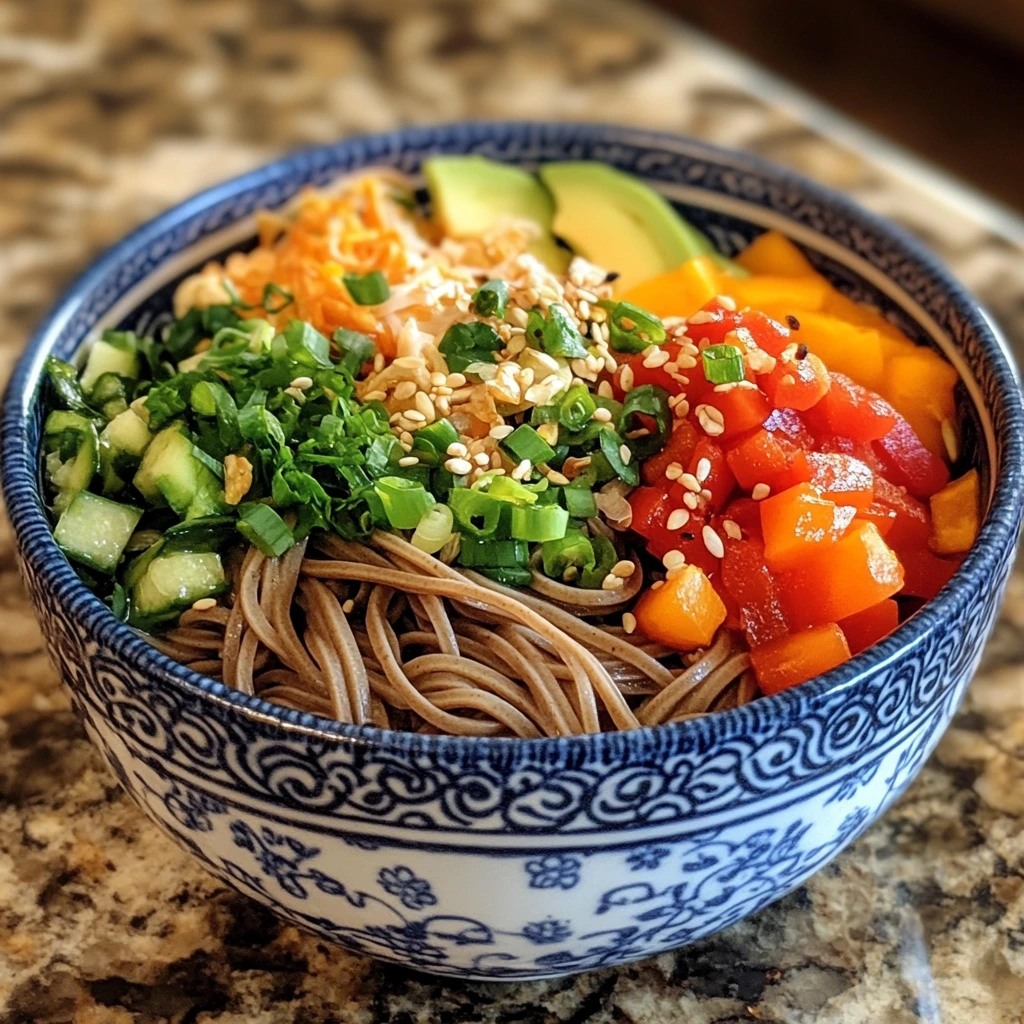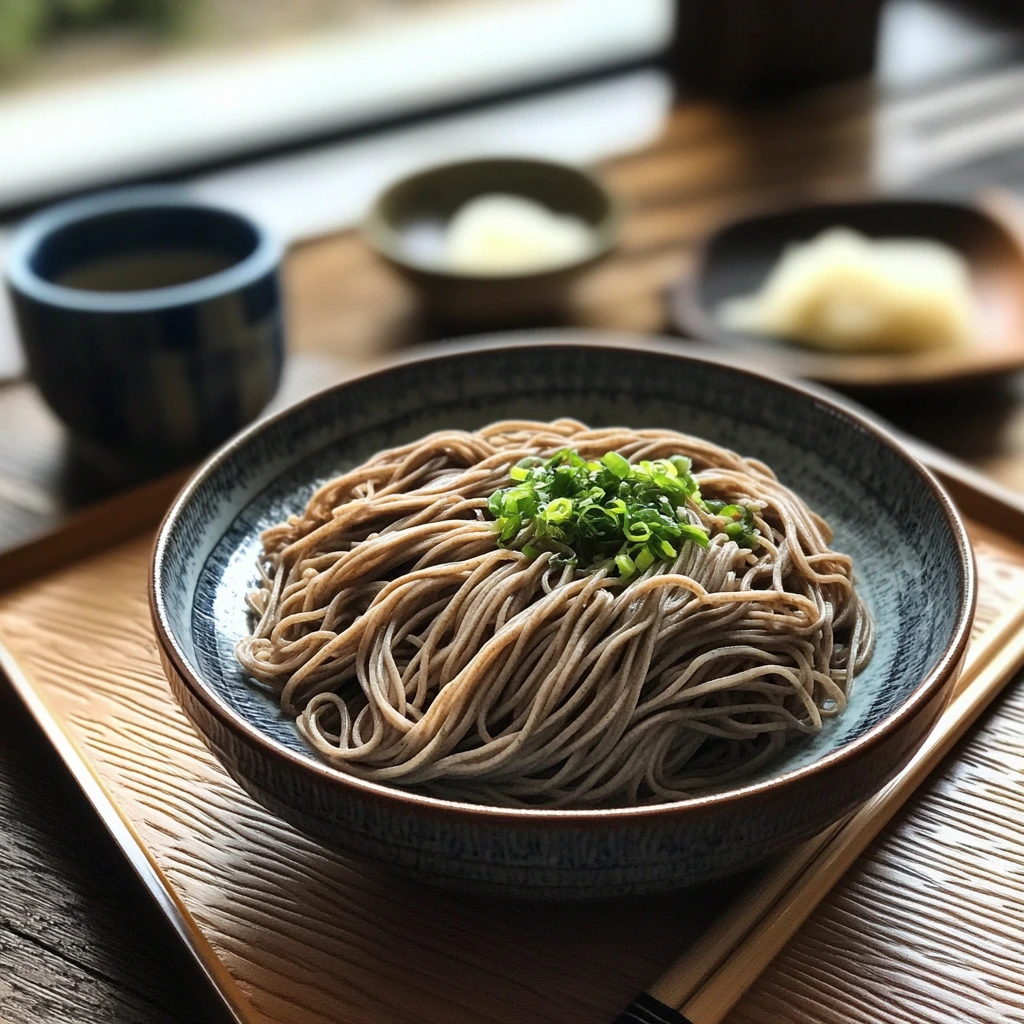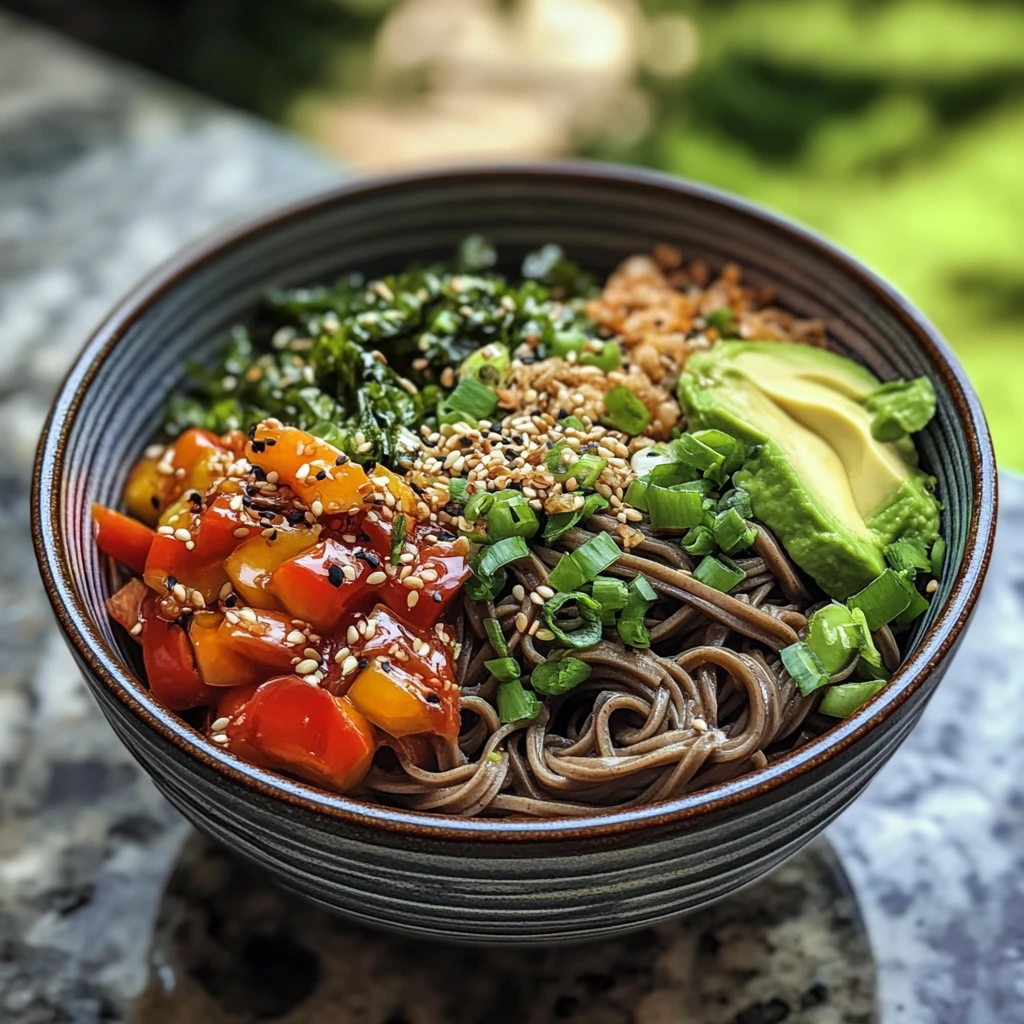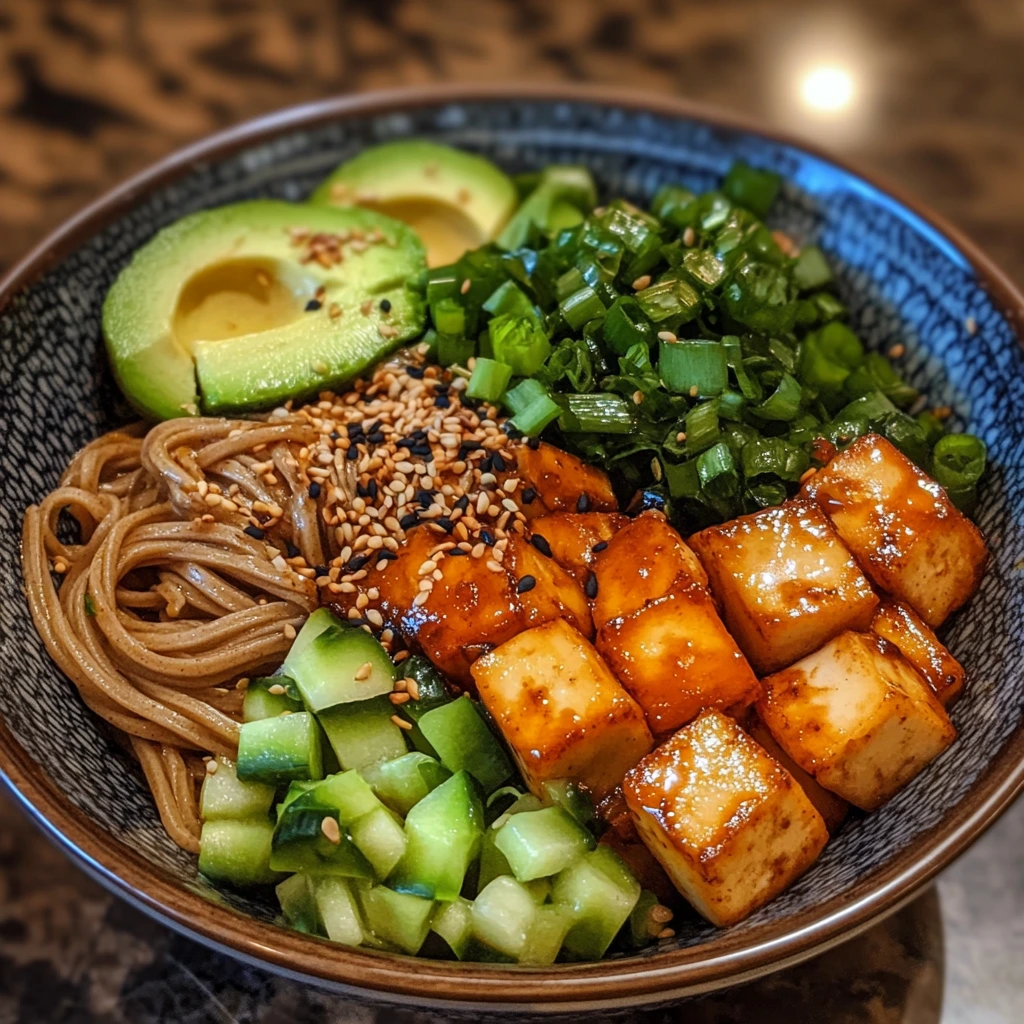Soba noodle bowls are a delicious and healthy staple of Japanese cuisine. Made from buckwheat, soba noodles offer a unique, nutty flavor and are naturally gluten-free. This dish combines tradition with freshness, offering endless possibilities for customization. Whether served in a warm, comforting broth or as a refreshing cold salad, Soba noodle bowls can be adapted to fit any dietary preference. In this post, we’ll explore how to create the perfect Soba Noodle Bowl, the health benefits of soba, and creative ways to enjoy this versatile meal. Let’s dive into the world of soba!
What Are Soba Noodles?
The Origin of Soba
Soba noodles have a long and rich history in Japan, dating back to the 8th century. They are believed to have been introduced by Chinese immigrants, but quickly became a beloved part of Japanese culture. The word “soba” refers to the buckwheat used in making the noodles.
Over time, soba became a symbol of health and longevity in Japan. Soba was traditionally served on special occasions, such as New Year’s Eve, to mark the transition to a new year. It was thought that eating soba would bring good fortune and long life.
Today, soba is enjoyed year-round, from casual meals to elegant dishes in fine dining. Despite its evolution, soba continues to hold a deep cultural significance in Japanese cuisine.

Buckwheat Base
Soba noodles are primarily made from buckwheat flour, which gives them their unique flavor and texture. Buckwheat is not actually a wheat but a gluten-free seed, making soba a great option for those with gluten sensitivities. The high nutritional value of buckwheat is another reason why soba is so popular. It’s rich in protein, fiber, and essential minerals like manganese and magnesium.
Additionally, buckwheat has antioxidant properties that support heart health. While some soba noodles may contain wheat flour to improve texture and elasticity, traditional soba focuses on using a higher percentage of buckwheat flour. This creates a more rustic, earthy taste.
The use of buckwheat in soba is also tied to Japanese agricultural practices, as the plant grows well in the cooler regions of Japan, thriving even in poor soil. This makes it an ideal, sustainable crop for noodle production.
Types of Soba Noodles
There are two main types of soba noodles: fresh and dried. Fresh soba noodles are made from scratch and are typically served immediately after preparation. They have a delicate texture and a more pronounced buckwheat flavor.
Dried soba noodles, on the other hand, are pre-made and can be stored for longer periods. They are more convenient and widely available in stores. Both types of soba can be used in cold or hot dishes. Cold soba, served with a dipping sauce, is popular in the summer, while hot soba is often enjoyed in a flavorful broth during colder months.
Another variation is “zaru soba,” which refers to cold soba noodles served on a bamboo tray with a side of dipping sauce. “Kake soba” refers to soba served in a hot broth. Each type offers a different experience and can be adapted to suit various preferences.
How to Make the Perfect Soba Noodle Bowl
Selecting the Right Soba Noodles
When choosing soba noodles, consider whether you want fresh or dried noodles. Fresh soba offers the best texture and flavor but has a shorter shelf life. If you’re making soba from scratch, fresh noodles are ideal. Dried soba noodles, while less delicate, are more convenient and can be stored for months.
For a more authentic experience, look for soba that contains at least 80% buckwheat flour, as this enhances the nutty flavor and texture. Some soba noodles use a mix of wheat flour for added elasticity, which can affect the taste. Consider the dish you’re preparing as well—cold soba works best with thinner noodles, while thicker soba noodles are better suited for soups.
Lastly, check the origin. Authentic Japanese soba, particularly from regions like Nagano or Kyoto, can offer superior quality and taste compared to mass-produced versions.

Traditional Soba Broth
The traditional soba broth, known as “tsuyu,” is a key component that enhances the flavor of the noodles. It’s made from a combination of dashi, soy sauce, and mirin. Dashi is a stock made from bonito flakes (dried fish) and kombu (seaweed), providing a deep umami flavor.
Soy sauce adds saltiness and a rich, savory depth, while mirin, a sweet rice wine, balances the overall taste. This broth can be served either hot or cold, depending on the dish. For a hot soba dish, the broth is heated to create a comforting, warming experience.
When serving cold soba, the broth is served on the side as a dipping sauce. Variations of soba broth may include different seasonings or additions like garlic, ginger, or sesame, but the balance between savory, sweet, and umami flavors remains essential to traditional soba preparation.
Adding Fresh Ingredients to Soba Noodle Bowl
Adding fresh ingredients to your Soba Noodle Bowl can elevate both the flavor and nutrition. Common toppings include green onions, which add a mild, refreshing crunch. Fresh herbs like cilantro or shiso leaves can provide an aromatic touch. Vegetables like cucumber, radish, and carrots add color, texture, and a crisp bite. For protein, tofu, tempura, or thinly sliced meats like chicken or pork work well.
You can also add a soft-boiled egg or fish cakes for extra richness. Nori (seaweed) is a traditional topping, offering a slightly salty, umami-packed flavor that complements soba perfectly. For a burst of heat, a dollop of wasabi or chili paste can spice up the bowl.
Lastly, sesame seeds or pickled vegetables like umeboshi can add tanginess and extra crunch. These fresh ingredients not only enhance the dish’s taste but also its visual appeal and nutritional value.
Healthy Benefits of Soba Noodle Bowl
Nutritional Value of Buckwheat
Buckwheat, the primary ingredient in soba noodles, is a highly nutritious food. It is rich in protein, making it a great plant-based protein source. Unlike most grains, buckwheat contains all nine essential amino acids, which are important for muscle repair and overall health.
It’s also packed with fiber, which aids in digestion and helps maintain a healthy gut. Buckwheat is full of antioxidants, such as rutin, which have anti-inflammatory and heart-protective properties. It also contains important minerals like magnesium, manganese, and iron, which support bone health, blood circulation, and energy production.
Another benefit of buckwheat is that it’s naturally gluten-free, making it an excellent choice for those with gluten sensitivities or celiac disease. Incorporating buckwheat into your diet can provide long-lasting energy while supporting overall well-being.

Soba Noodle Bowl: Low in Calories, High in Taste
Soba Noodle Bowl is an excellent choice for those looking for a flavorful, low-calorie meal. A typical serving of soba noodles is lower in calories compared to traditional pasta, making it a great option for weight management.
Despite their lower calorie content, soba noodles are packed with flavor, thanks to the earthy taste of buckwheat. When paired with a savory broth and fresh toppings, they create a satisfying, balanced meal. The natural nuttiness of buckwheat enhances the overall taste without the need for heavy sauces or excess fat.
Additionally, soba noodles are rich in fiber and protein, providing long-lasting fullness without the calorie overload of other noodle dishes. Whether served hot in a comforting soup or cold with a refreshing dip, soba offers a deliciously light option that doesn’t sacrifice taste or satisfaction.
Customizable for Dietary Needs
Soba Noodle Bowl is highly versatile, making it easy to adapt to various dietary needs. For those following a gluten-free diet, soba noodles made from 100% buckwheat flour are the perfect choice. They are naturally gluten-free, providing a safe option for individuals with celiac disease or gluten sensitivity.
Soba Noodle Bowl can also be easily customized to be vegan or vegetarian. Simply replace animal-based protein with tofu, tempeh, or additional vegetables. For low-sodium diets, you can control the amount of soy sauce or use a reduced-sodium version in the broth.
Soba Noodle Bowl can be served with a variety of fresh vegetables, allowing you to pack in extra nutrients while maintaining a low-calorie meal. Whether you’re looking for a hearty, protein-packed meal or a light, plant-based option, Soba Noodle Bowl can easily fit into any dietary plan without sacrificing flavor.
Creative Soba Noodle Bowl Variations
Cold Soba Noodle Bowl
A cold Soba Noodle Bowl is a refreshing dish, perfect for warm weather. The noodles are cooked, then chilled in cold water to firm up and achieve a satisfying texture. Once cooled, the soba is typically served on a bamboo tray, known as “zaru,” along with a side of dipping sauce called “tsuyu.” The sauce is made from a blend of dashi, soy sauce, and mirin.
Toppings such as sliced green onions, wasabi, and grated daikon radish add flavor and texture to the dish. For added protein, you can top your cold soba with tofu, shrimp, or a soft-boiled egg.
Cold Soba Bowl is light yet filling, making it a great choice for a quick, healthy meal. The cool, crisp noodles combined with the savory dipping sauce create a satisfying balance of flavors, perfect for a hot summer day.

Hot Soba Noodle Soup
Hot Soba Noodle Soup is a comforting dish, perfect for colder months. The soba noodles are served in a flavorful broth made from dashi, soy sauce, and mirin. The warm broth soaks into the noodles, creating a hearty and satisfying meal.
Toppings such as sliced green onions, tempura, or a soft-boiled egg enhance the dish’s richness. Commonly, hot soba soup is served with seasonal vegetables like mushrooms or spinach, adding freshness and color. Some variations include a protein, like thinly sliced chicken or pork, which adds flavor and substance. Hot Soba Bowl is often enjoyed with a side of wasabi or pickles for extra zing.
The warmth of the soup, combined with the savory broth, makes hot soba a cozy and nourishing meal. Whether enjoyed as a quick lunch or a comforting dinner, it’s a versatile dish that brings both warmth and satisfaction.
Vegan Soba Noodle Bowl
A vegan Soba Noodle Bowl is a delicious, plant-based version of the traditional dish. The soba noodles, made from buckwheat, are naturally vegan, offering a hearty base. For the broth, you can use vegetable stock, tamari (a gluten-free soy sauce), and mirin, creating a savory, umami-rich flavor.
Toppings for a vegan Soba Noodle Bowl can include crispy tofu, edamame, and a variety of fresh vegetables like cucumbers, carrots, and radishes. Avocado adds creaminess, while nori (seaweed) provides a salty, umami punch. You can also add sesame seeds for extra texture and flavor. This dish can be served either hot or cold, depending on your preference.
A vegan Soba Noodle Bowl is not only full of flavor but also packed with nutrients like protein, fiber, and healthy fats. It’s a versatile, easy-to-make meal, perfect for those following a plant-based diet or looking for a lighter, healthier meal.

Why Soba Noodle Bowl is Perfect for Any Occasion
Quick and Easy Meal
Soba Noodle Bowl is an excellent choice for a quick and easy meal. Cooking soba noodles only takes about 5 to 7 minutes, making them a fast option for busy days. Once the noodles are ready, you can customize your bowl with simple toppings like sliced vegetables, tofu, or a boiled egg.
The broth can be prepared in advance or made in minutes using basic ingredients like soy sauce, dashi, and mirin. For a cold Soba Noodle Bowl, the noodles are chilled, and the dipping sauce is ready to serve. You can also use store-bought soba noodles for added convenience.
With minimal prep time and few ingredients, Soba Noodle Bowl provides a flavorful, satisfying meal in no time. Whether for lunch or dinner, they are an easy go-to option that doesn’t sacrifice taste or nutrition.
Soba Noodle Bowl: Ideal for Family Meals
Soba Noodle Bowl is perfect for family meals due to its versatility and ease of preparation. Each person can customize their bowl with their favorite ingredients, making it a fun and interactive meal. You can prepare a large pot of soba noodles and set out a variety of toppings, such as vegetables, tofu, and eggs. This allows everyone to build their bowl to suit their tastes.
The broth can also be served on the side for dipping or poured over the noodles. Whether serving hot soba in a comforting soup or cold soba with a refreshing dip, both options are easy to make in large quantities.
Soba Noodle Bowl is not only quick to prepare, but it’s also nutritious and satisfying for all ages. It offers a well-rounded meal that can please both picky eaters and those with dietary restrictions.
Balance of Tradition and Freshness
Soba Noodle Bowl beautifully balances traditional Japanese flavors with fresh, modern ingredients. The traditional elements, like the buckwheat noodles and dashi-based broth, provide a deep, authentic taste rooted in Japanese culture.
These classic components are the foundation of soba, offering a savory, comforting experience. At the same time, the addition of fresh vegetables, herbs, and proteins allows for customization, bringing new flavors and textures to the dish. Ingredients like avocado, sesame seeds, or grilled tofu add a contemporary twist, making the bowl lighter and more vibrant.
This combination of traditional and fresh elements makes soba noodles a timeless dish that can be enjoyed in many ways. Whether you prefer the simplicity of a classic bowl or a creative, modern variation, soba remains a perfect balance of the old and new, satisfying both the palate and the spirit.
Conclusion
In conclusion, Soba Noodle Bowl offers a delightful mix of tradition and freshness. With their rich history, versatile ingredients, and customizable nature, they are perfect for any occasion. Whether you prefer a warm, comforting bowl or a refreshing cold version, soba caters to all tastes and dietary needs.
The nutritional benefits of buckwheat, combined with the balance of flavors, make soba both satisfying and healthy. So, try creating your own Soba Noodle Bowl and enjoy the harmony of taste and tradition in every bite!

